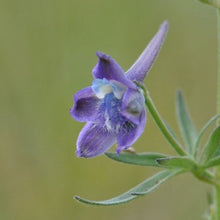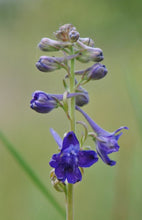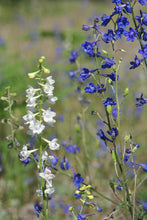Delphinium nuttallii
Nuttall’s Larkspur is sure to brighten up any garden with its stately structure and abundant, iridescent purplish-blue flowers. Flowers appear in late spring and early summer and have a long “spur” projecting backwards. Delphinium nuttallii is visually similar to D. menziesii, but can be distinguished by it’s smaller but more plentiful flowers. In rare cases, both species produce populations with yellowish flowers.
- Plant type/canopy layer: deciduous, perennial, herbaceous plant
- Size at maturity: 8” - 20” tall, 8”-12” wide
- Light requirements: full sun to part sun/part shade
- Moisture requirements: moist, well-drained soil
- Bloom time: May - June
- Growth rate/ease: moderate growth rate, easy to grow
- Wildlife support: unknown
- Native habitat/range: Locally common on low moist sites such as prairie-oak ecosystems, gravelly outwashes, basalt cliffs and rocky outcroppings, especially in prairies of the south Puget Sound and northern Willamette Valley. Portland Plant List - yes.
- Special features & uses: A blue dye or ink can be made from the flowers, which native peoples traditionally use for coloring arrows and other items and sometimes in ceremony. All parts of the plant are toxic - especially to livestock so it should not be planted on pasturelands or other grazing areas.
Gardening with Nuttel’s Larkspur: This is a generally carefree plant, requiring little special treatment. Simply plant this species in partial to full sun with moist, well-draining gravelly soils, then sit back, and watch it thrive. May require infrequent summer water when planted in the sunniest of locations (i.e. a deep watering every few weeks).
Photo Credit 1: "Delphinium nuttallii - Upland Larkspur (7)" by A_Nautilus is licensed under CC BY-NC-SA 2.0
Photo Credit 2: "Delphinium nuttallii - Upland Larkspur (19)" by A_Nautilus is licensed under CC BY-NC-SA 2.0
Photo Credit 3: "Delphinium nuttallii - Upland Larkspur" by A_Nautilus is licensed under CC BY-NC-SA 2.0






